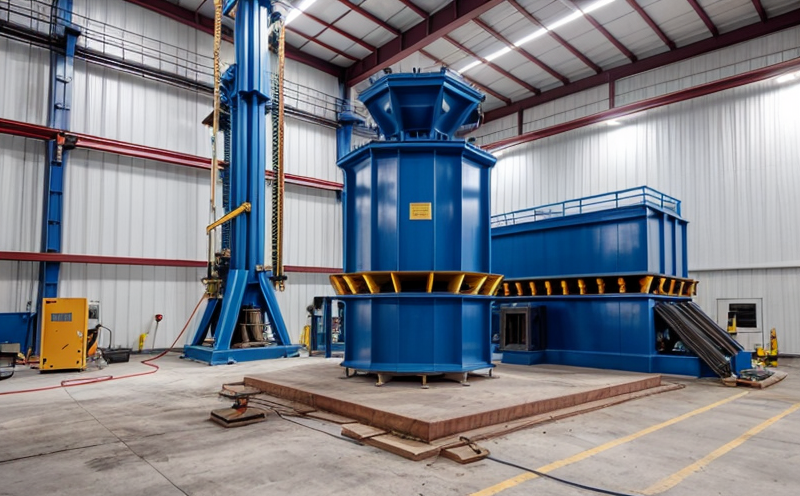ASTM E1876 Structural Resonant Vibration Analysis
The ASTM E1876 Structural Resonant Vibration Analysis is a critical method used to evaluate the dynamic characteristics of structural components and assemblies. This test is pivotal in ensuring that structures function as intended under various operational conditions, especially where vibration-induced stresses could compromise durability or performance.
ASTM E1876 focuses on identifying resonant frequencies, mode shapes, and damping ratios of a structure when subjected to external excitation forces. The primary objective is to determine the natural frequency at which a structure will vibrate most intensely, as this can lead to failure under operational conditions. This service plays a significant role in industries where structural integrity is paramount, such as aerospace, automotive, and manufacturing.
The test involves applying controlled sinusoidal excitation forces to specific points on the specimen, typically using shakers or impact hammers. Sensors are strategically placed to capture displacement, acceleration, and velocity data at various locations across the structure. The resulting data is then processed to identify resonant frequencies and mode shapes. This process ensures that any potential structural weaknesses can be identified early in the design cycle.
The ASTM E1876 procedure requires precise calibration of testing equipment and adherence to standard operating procedures. Specimen preparation involves ensuring that the structure being tested is representative of its intended use, which may include removing or securing non-essential components during testing. The specimen must be securely mounted on a vibration test stand with adequate support to prevent any premature failure.
The analysis of the collected data is crucial for interpreting the results accurately. This involves using specialized software to plot frequency response functions and contour plots that display mode shapes. The natural frequencies identified through this process are compared against design specifications to ensure compliance with industry standards such as ISO, ASTM, EN, and ASME.
The application of ASTM E1876 extends beyond mere compliance; it also provides valuable insights into the structural behavior under dynamic loading conditions. By understanding these parameters early in the development cycle, engineers can make informed decisions regarding material selection, design modifications, and manufacturing processes to enhance durability and safety.
- Quality and Reliability Assurance: Ensures that structures meet rigorous performance criteria under dynamic loads.
- Customer Impact and Satisfaction: Enhances product reliability leading to improved customer satisfaction by reducing the risk of failure in service.
This testing method is particularly valuable for industries where operational safety and efficiency are critical. By leveraging ASTM E1876, manufacturers can ensure that their products meet stringent quality standards while also providing a competitive edge through innovation and reliability.
Industry Applications
The ASTM E1876 Structural Resonant Vibration Analysis is widely used across various sectors where structural integrity and performance are paramount. In the aerospace industry, this test helps in evaluating components subjected to high-frequency vibration environments found during flight. Automotive manufacturers use it to assess the durability of vehicle parts under dynamic loads, ensuring they meet stringent safety standards.
In manufacturing, this service is essential for testing large-scale machinery and equipment that operate with significant vibrations. By identifying potential resonant frequencies early in the design phase, engineers can minimize the risk of premature failure during operation. This not only enhances product reliability but also reduces maintenance costs and downtime associated with unforeseen failures.
The aerospace sector particularly benefits from this test due to the stringent requirements for operational safety under dynamic conditions. Aircraft components such as landing gear, engine mounts, and wing structures are subjected to rigorous testing to ensure they can withstand the extreme vibrations encountered during takeoff and landing. Similarly, in the automotive industry, suspension systems, exhaust systems, and other critical components undergo this analysis to guarantee durability and performance.
Manufacturing facilities also rely on ASTM E1876 for testing large machines like presses, conveyors, and generators that operate under dynamic conditions. By identifying resonant frequencies early in the design process, manufacturers can optimize their designs to enhance longevity and efficiency. This service is equally important in industries such as shipbuilding, where structures must withstand harsh oceanic environments with minimal vibration-induced damage.
The automotive industry further benefits from this testing method by evaluating components under realistic operating conditions. Suspension systems, exhaust systems, and other critical parts are subjected to dynamic loading to ensure they meet stringent safety standards. This ensures that vehicles perform reliably under various driving conditions, enhancing customer satisfaction and trust in the brand.
Quality and Reliability Assurance
The ASTM E1876 Structural Resonant Vibration Analysis is integral to ensuring high-quality outputs and reliable performance of products across diverse industries. By identifying resonant frequencies, mode shapes, and damping ratios early in the design process, this method allows manufacturers to make informed decisions regarding material selection and manufacturing processes.
- Quality Control: Ensures that all components meet stringent quality standards before being integrated into larger assemblies.
- Risk Mitigation: Identifies potential structural weaknesses early in the design phase, mitigating risks of failure during service.
The process involves precise calibration of testing equipment and adherence to standard operating procedures. Specimen preparation is crucial for ensuring that the structure being tested accurately represents its intended use. This includes removing or securing non-essential components during testing to prevent any premature failure. The secure mounting of specimens on vibration test stands with adequate support further enhances the reliability of the results.
The analysis of collected data provides valuable insights into structural behavior under dynamic loading conditions. By identifying natural frequencies and mode shapes, engineers can optimize designs for enhanced durability and safety. This ensures that products meet not only regulatory requirements but also exceed customer expectations in terms of performance and longevity.
Through rigorous quality control measures and risk mitigation strategies, this service helps maintain a high level of product reliability, which is critical for industries where operational efficiency and safety are paramount. By leveraging ASTM E1876, manufacturers can ensure that their products not only meet stringent quality standards but also provide a competitive edge through innovation and reliability.





